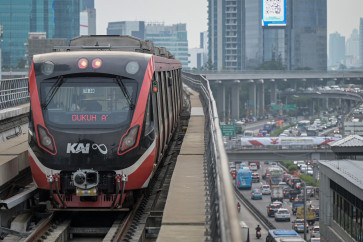Tightening bilateral ties through sumo
Celebrating relations: Two sumo wrestlers try to force each other out of the ring at the Jakarta Sumo Tournament 2013 on Saturday
Change text size
Gift Premium Articles
to Anyone
 Celebrating relations: Two sumo wrestlers try to force each other out of the ring at the Jakarta Sumo Tournament 2013 on Saturday. The tournament is held to commemorate the 55th anniversary of Indonesian-Japanese bilateral ties. (JP/Nurhayati) (JP/Nurhayati)
Celebrating relations: Two sumo wrestlers try to force each other out of the ring at the Jakarta Sumo Tournament 2013 on Saturday. The tournament is held to commemorate the 55th anniversary of Indonesian-Japanese bilateral ties. (JP/Nurhayati) (JP/Nurhayati)
C
span class="caption" style="width: 510px;">Celebrating relations: Two sumo wrestlers try to force each other out of the ring at the Jakarta Sumo Tournament 2013 on Saturday. The tournament is held to commemorate the 55th anniversary of Indonesian-Japanese bilateral ties. (JP/Nurhayati)
The first sumo tournament in Jakarta proved a hit on Saturday, attracting thousands who were curious about watching the ancient Japanese martial arts tournament.
Many of them brought their children along, with some of the Japanese children wearing yukata (summer kimono) to the venue at Istora Senayan, Jakarta on Saturday.
Enthusiasm was palpable. Many of the crowds wandered around to find a chance to take photographs with sumo wrestlers.
Awi, 29, who came to the tournament with two of her nieces, said that it was a good event to introduce her nieces to foreign traditions and culture.
'My nieces and I only knew that sumo wrestlers are a bunch of huge, scary people who fight each other, but after seeing this tournament we realize that sumo wrestlers are not that scary,' she said.
Each match of the sumo wrestling only lasts for few minutes, until one of the wrestlers is forced to go out of the circular ring (dohyo) or touch the ground with anything other than the soles of the their feet.
The sumo tournament was held to commemorate Japan and Indonesia's diplomatic relationship that have spanned 55 years as well as Japan and ASEAN 40 year relations.
According to Takuji Yoshida, Chairman of Gotanda Denshi, promoter of the tournament, the first day of the two-day event was attended by 7,235 people, with 38 professional rikishi (professional sumo wrestlers) competing in the first sumo tournament held in a South East Asian country.
Two sumo wrestlers, Chiyokozuni and Takekaze, that were supposed to compete in the first day of the tournament had to withdraw due to health problems.
Yoshida said that the winner of the two-day tournament would be able to be promoted to the higher rank of the sumo wrestlers.
The first day event saw Kisenosato Yutaka, an ozeki-ranked sumo wrestler defeat one of the yokozuna-ranked (grand champion) wrestlers Harumafuji.
The top division of professional sumo wrestlers is called maakuchi and comprises of 42 rikishis, which are divided into five ranks defined by their performance in previous tournaments. At the top of the maakuchi division are yokozuna followed by ozeki, sekiwake and komusubi ' usually comprised of 8-12 wrestlers ' while the remaining wrestlers are called maegashira.
With a long history dated back to 1,500 years ago, sumo can be found in the myths of trials of strength and traditions of imperial contest described in the Kojiki (Japan's oldest extant writing dates 712) and Nihon-shoki (the oldest chronicles of Japan dated 720).
Sumo bouts have been carried out as Shinto (indigenous spirituality of Japanese people) rituals at festivals to pray for a good harvest. In the eighth century, sumo became an imperial court event for three hundred years.
According to Yamamori Takashi, a 30-year-old Japanese man, he was really glad to see the sumo tournament held outside Japan, especially seeing the response of Indonesian audience.
'It's good to introduce the values of sumo that Japanese people adhere to by including fighting spirit and hard work,' he said.
He added that in Japan, tickets for the sumo tournament were relatively more expensive than the tickets sold in Indonesia. In Japan the minimum price of a sumo tournament would be around Rp 500,000 (US$40) while the minimum ticket price in Jakarta was only Rp 220,000.









